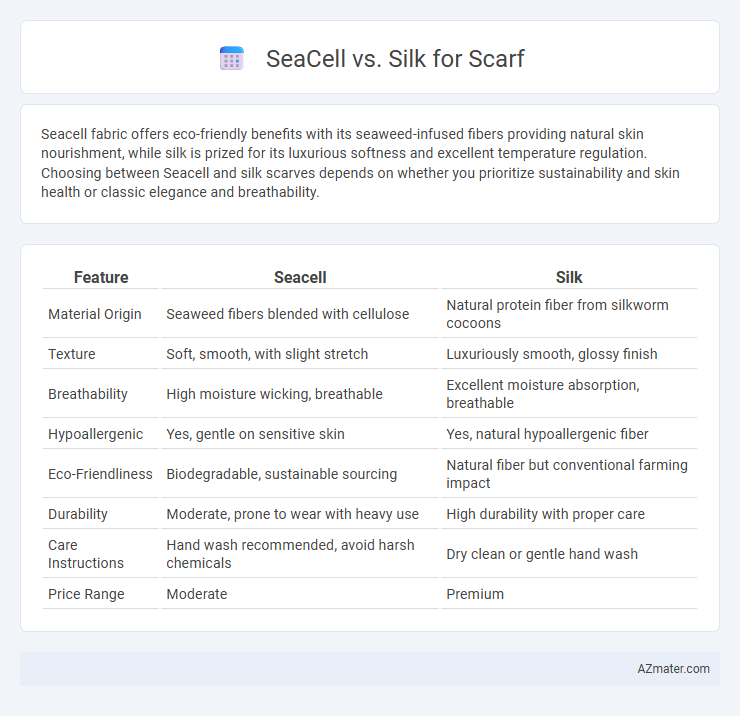Seacell fabric offers eco-friendly benefits with its seaweed-infused fibers providing natural skin nourishment, while silk is prized for its luxurious softness and excellent temperature regulation. Choosing between Seacell and silk scarves depends on whether you prioritize sustainability and skin health or classic elegance and breathability.
Table of Comparison
| Feature | Seacell | Silk |
|---|---|---|
| Material Origin | Seaweed fibers blended with cellulose | Natural protein fiber from silkworm cocoons |
| Texture | Soft, smooth, with slight stretch | Luxuriously smooth, glossy finish |
| Breathability | High moisture wicking, breathable | Excellent moisture absorption, breathable |
| Hypoallergenic | Yes, gentle on sensitive skin | Yes, natural hypoallergenic fiber |
| Eco-Friendliness | Biodegradable, sustainable sourcing | Natural fiber but conventional farming impact |
| Durability | Moderate, prone to wear with heavy use | High durability with proper care |
| Care Instructions | Hand wash recommended, avoid harsh chemicals | Dry clean or gentle hand wash |
| Price Range | Moderate | Premium |
Introduction to Seacell and Silk Scarves
Seacell scarves are crafted from fibers infused with algae extracts, offering natural moisturizing properties and a soft, breathable texture ideal for sensitive skin. Silk scarves boast a luxurious, smooth feel with excellent temperature regulation, providing lightweight warmth and elegance. Both materials deliver unique benefits, with Seacell focusing on eco-friendly innovation and skin nourishment, while silk emphasizes timeless softness and durability.
What is Seacell Fiber?
Seacell fiber is an innovative textile made by integrating seaweed extracts with cellulose fibers, offering natural skin-soothing properties and enhanced breathability. Silk, known for its luxurious texture and sheen, lacks the bioactive compounds found in Seacell, which contribute to moisture management and antioxidant benefits. Scarves made from Seacell fibers provide a unique combination of eco-friendly materials and functional wear, making them suitable for sensitive skin and environmentally conscious consumers.
Understanding Silk: The Timeless Fabric
Silk, a natural protein fiber derived from silkworms, is prized for its luxurious softness, sheen, and breathability, making it a timeless choice for scarves. It offers excellent moisture-wicking properties and temperature regulation, ensuring comfort in both warm and cool conditions. Compared to Seacell, which incorporates seaweed fibers for eco-friendly benefits and skin nourishment, silk excels in durability and a classic aesthetic appeal.
Texture and Feel: Seacell vs Silk
Seacell scarves offer a soft, breathable texture with a subtle sheen, blending natural seaweed fibers and wood pulp for enhanced moisture absorption and skin-friendly properties. Silk scarves provide a smooth, luxurious feel with a natural gloss and lightweight drape, valued for their hypoallergenic and temperature-regulating qualities. Compared to silk, Seacell has a slightly more textured surface, making it ideal for those seeking eco-friendly fabrics with balanced softness and durability.
Breathability and Moisture Management
Seacell scarves excel in breathability due to their innovative blend of seaweed fibers and natural cellulose, which enhance airflow and wick moisture effectively, keeping the skin dry and comfortable. Silk scarves, while luxurious and smooth, offer moderate breathability but tend to retain moisture longer, making them less efficient in moisture management compared to Seacell. For active wear or humid conditions, Seacell provides superior moisture regulation and ventilation, ensuring better comfort throughout the day.
Skin Benefits: Seacell vs Silk
Seacell fabric, infused with seaweed fibers, offers natural antioxidant, anti-inflammatory, and moisturizing properties that promote healthier, hydrated skin when worn as a scarf. Silk, renowned for its smooth texture, reduces friction on sensitive skin, minimizing irritation and helping to retain skin moisture through its hypoallergenic nature. Comparing the two, Seacell provides active skin-nourishing benefits, while silk excels in gentle, protective care and moisture retention.
Eco-Friendliness and Sustainability
Seacell scarves, made from seaweed-infused fibers, offer excellent eco-friendliness due to their biodegradable and renewable marine-derived materials that support ocean health. Silk scarves, while natural and biodegradable, involve intensive water use and mulberry cultivation impacting water resources, making them less sustainable in comparison. Choosing Seacell embraces a circular textile economy with minimal chemical processing and sustainable fiber regeneration, promoting greener fashion options.
Durability and Care Instructions
Seacell scarves offer excellent durability due to their combination of seaweed fibers and natural cellulose, resisting wear while maintaining softness after multiple washes. Silk scarves, known for their luxurious sheen, require delicate care such as hand washing in cold water or dry cleaning to preserve fiber integrity and prevent damage. Both materials benefit from gentle handling, but Seacell tends to withstand frequent use and laundering better than traditional silk.
Price Comparison: Seacell vs Silk Scarves
Seacell scarves typically range from $50 to $120, offering a blend of biodegradable seaweed fibers and soft fabric that appeals to eco-conscious consumers. Silk scarves, priced between $70 and $200, vary greatly depending on the quality of silk, with pure mulberry silk commanding higher prices. When comparing price points, Seacell scarves present a more affordable sustainable option, while silk scarves provide a luxury feel at a premium cost.
Which is Better for Scarves?
Seacell fabric, infused with seaweed fibers, offers natural moisture-wicking and antibacterial properties, making it ideal for scarves that enhance skin health and comfort. Silk, known for its luxurious softness and smooth texture, excels in temperature regulation and elegance, providing a lightweight, breathable option for scarves. For scarves, Seacell is better suited for those seeking functional benefits like skin nourishment, while silk is preferred for a classic, high-end aesthetic and gentle touch against the skin.

Infographic: Seacell vs Silk for Scarf
 azmater.com
azmater.com